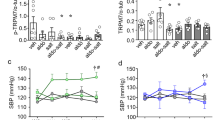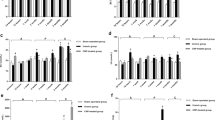Abstract
The mineralocorticoids aldosterone and deoxycorticosterone acetate (DOCA) stimulate renal tubular salt reabsorption, increase salt appetite, induce extracellular volume expansion, and elevate blood pressure. Cardiac effects of mineralocorticoids include stimulation of matrix protein deposition leading to cardiac fibrosis, which is at least partially due to the direct action of the hormones on cardiac cells. The signaling mechanisms mediating mineralocorticoid-induced cardiac fibrosis have so far remained elusive. Mineralocorticoids have been shown to upregulate the serum- and glucocorticoid-inducible kinase 1 (SGK1), which participates in the effects of mineralocorticoids on renal tubular Na+ reabsorption and salt appetite. To explore the involvement of SGK1 in the pathogenesis of mineralocorticoid-induced cardiac fibrosis, SGK1 knockout mice (sgk1 −/−) and wild-type littermates (sgk1 +/+) were implanted a 21-day-release 50-mg DOCA pellet and supplied with 1% NaCl in drinking water for 18 days. This DOCA/high-salt treatment increased blood pressure in both genotypes but led to significant cardiac fibrosis only in sgk1 +/+ but not in sgk1 −/− mice. According to real-time polymerase chain reaction and Western blotting, DOCA/high-salt treatment enhanced transcript levels and protein expression of cardiac connective tissue growth factor (CTGF) only in sgk1 +/+ but not in sgk1 −/− mice. Furthermore, DOCA (10 μM) upregulated CTGF expression and enhanced CTGF promoter activity in lung fibroblasts isolated from sgk1 +/+ but not from sgk1 −/− mice, an effect involving spironolactone-sensitive mineralocorticoid receptors and activation of nuclear factor-κB (NFκB). Our results suggest that SGK1 plays a decisive role in mineralocorticoid-induced CTGF expression and cardiac fibrosis.



Similar content being viewed by others
References
Zhang S, Weinheimer C, Courtois M, Kovacs A, Zhang CE, Cheng AM, Wang Y, Muslin AJ (2003) The role of the Grb2-p38 MAPK signaling pathway in cardiac hypertrophy and fibrosis. J Clin Invest 111:833–841
Allessie M, Schotten U, Verheule S, Harks E (2005) Gene therapy for repair of cardiac fibrosis: a long way to Tipperary. Circulation 111:391–393
Swynghedauw B (1999) Molecular mechanisms of myocardial remodeling. Physiol Rev 79:215–262
Young M, Head G, Funder J (1995) Determinants of cardiac fibrosis in experimental hypermineralocorticoid states. Am J Physiol 269:E657–E662
Reilly RF, Ellison DH (2000) Mammalian distal tubule: physiology, pathophysiology, and molecular anatomy. Physiol Rev 80:277–313
Stellar E, Epstein AN (1991) Neuroendocrine factors in salt appetite. J Physiol Pharmacol 42:345–355
Vallon V, Huang DY, Grahammer F, Wyatt AW, Osswald H, Wulff P, Kuhl D, Lang F (2005) SGK1 as a determinant of kidney function and salt intake in response to mineralocorticoid excess. Am J Physiol Regul Integr Comp Physiol 289:R395–R401
Connell JM, Fraser R, MacKenzie S, Davies E (2003) Is altered adrenal steroid biosynthesis a key intermediate phenotype in hypertension? Hypertension 41:993–999
Brilla CG, Weber KT (1992) Reactive and reparative myocardial fibrosis in arterial hypertension in the rat. Cardiovasc Res 26:671–677
Young MJ, Funder JW (1996) The renin–angiotensin–aldosterone system in experimental mineralocorticoid–salt-induced cardiac fibrosis. Am J Physiol 271:E883–E888
Fullerton MJ, Funder JW (1994) Aldosterone and cardiac fibrosis: in vitro studies. Cardiovasc Res 28:1863–1867
Zhou G, Kandala JC, Tyagi SC, Katwa LC, Weber KT (1996) Effects of angiotensin II and aldosterone on collagen gene expression and protein turnover in cardiac fibroblasts. Mol Cell Biochem 154:171–178
Pearce D (2003) SGK1 regulation of epithelial sodium transport. Cell Physiol Biochem 13:013–020
Verrey F, Loffing J, Zecevic M, Heitzmann D, Staub O (2003) SGK1: aldosterone-induced relay of Na+ transport regulation in distal kidney nephron cells. Cell Physiol Biochem 13:021–028
Firestone GL, Giampaolo JR, O’Keeffe BA (2003) Stimulus-dependent regulation of the serum and glucocorticoid inducible protein kinase (Sgk) transcription, subcellular localization and enzymatic activity. Cell Physiol Biochem 13:1–12
Lang F, Klingel K, Wagner CA, Stegen C, Warntges S, Friedrich B, Lanzendorfer M, Melzig J, Moschen I, Steuer S, Waldegger S, Sauter M, Paulmichl M, Gerke V, Risler T, Gamba G, Capasso G, Kandolf R, Hebert SC, Massry SG, Broer S (2000) Deranged transcriptional regulation of cell-volume-sensitive kinase hSGK in diabetic nephropathy. Proc Natl Acad Sci U S A 97:8157–8162
Lang F, Cohen P (2001) Regulation and physiological roles of serum- and glucocorticoid-induced protein kinase isoforms. Sci STKE 2001:RE17
Feng Y, Wang Q, Wang Y, Yard B, Lang F (2005) SGK1-mediated fibronectin formation in diabetic nephropathy. Cell Physiol Biochem 16:237–244
Friedrich B, Wärntges S, Klingel K, Sauter M, Kandolf R, Risler T, Müller GA, Witzgall R, Kriz W, Gröne HJ, Lang F (2002) Up-regulation of the human serum and glucocorticoid-dependent kinase 1 in glomerulonephritis. Kidney Blood Press Res 25:303–307
Waldegger S, Klingel K, Barth P, Sauter M, Rfer ML, Kandolf R, Lang F (1999) h-sgk Serine–threonine protein kinase gene as transcriptional target of transforming growth factor beta in human intestine. Gastroenterology 116:1081–1088
Wärntges S, Klingel K, Weigert C, Fillon S, Buck M, Schleicher E, Rodemann HP, Knabbe C, Kandolf R, Lang F (2002) Excessive transcription of the human serum and glucocorticoid dependent kinase hSGK1 in lung fibrosis. Cell Physiol Biochem 12:135–142
Fillon S, Klingel K, Warntges S, Sauter M, Gabrysch S, Pestel S, Tanneur V, Waldegger S, Zipfel A, Viebahn R, Haussinger D, Broer S, Kandolf R, Lang F (2002) Expression of the serine/threonine kinase hSGK1 in chronic viral hepatitis. Cell Physiol Biochem 12:47–54
Klingel K, Warntges S, Bock J, Wagner CA, Sauter M, Waldegger S, Kandolf R, Lang F (2000) Expression of cell volume-regulated kinase h-sgk in pancreatic tissue. Am J Physiol Gastrointest Liver Physiol 279:G998–G1002
Wulff P, Vallon V, Huang DY, Volkl H, Yu F, Richter K, Jansen M, Schlunz M, Klingel K, Loffing J, Kauselmann G, Bosl MR, Lang F, Kuhl D (2002) Impaired renal Na(+) retention in the sgk1-knockout mouse. J Clin Invest 110:1263–1268
Hartner A, Cordasic N, Klanke B, Muller U, Sterzel RB, Hilgers KF (2002) The alpha8 integrin chain affords mechanical stability to the glomerular capillary tuft in hypertensive glomerular disease. Am J Pathol 160:861–867
Johns C, Gavras I, Handy DE, Salomao A, Gavras H (1996) Models of experimental hypertension in mice. Hypertension 28:1064–1069
Klingel K, Hohenadl C, Canu A, Albrecht M, Seemann M, Mall G, Kandolf R (1992) Ongoing enterovirus-induced myocarditis is associated with persistent heart muscle infection: quantitative analysis of virus replication, tissue damage, and inflammation. Proc Natl Acad Sci U S A 89:314–318
Gorlach A, Diebold I, Schini-Kerth VB, Berchner-Pfannschmidt U, Roth U, Brandes RP, Kietzmann T, Busse R (2001) Thrombin activates the hypoxia-inducible factor-1 signaling pathway in vascular smooth muscle cells: role of the p22(phox)-containing NADPH oxidase. Circ Res 89:47–54
Fujisawa G, Dilley R, Fullerton MJ, Funder JW (2001) Experimental cardiac fibrosis: differential time course of responses to mineralocorticoid–salt administration. Endocrinology 142:3625–3631
Frazier K, Williams S, Kothapalli D, Klapper H, Grotendorst GR (1996) Stimulation of fibroblast cell growth, matrix production, and granulation tissue formation by connective tissue growth factor. J Invest Dermatol 107:404–411
Dammeier J, Beer HD, Brauchle M, Werner S (1998) Dexamethasone is a novel potent inducer of connective tissue growth factor expression. Implications for glucocorticoid therapy. J Biol Chem 273:18185–18190
Sicard RE, Werner JC (1994) Dexamethasone-induced histopathology of neonatal rat myocardium. In Vivo 8:353–358
Blom IE, Goldschmeding R, Leask A (2002) Gene regulation of connective tissue growth factor: new targets for antifibrotic therapy? Matrix Biol 21:473–482
Zhang L, Cui R, Cheng X, Du J (2005) Antiapoptotic effect of serum and glucocorticoid-inducible protein kinase is mediated by novel mechanism activating I{kappa}B kinase. Cancer Res 65:457–464
Yu HC, Burrell LM, Black MJ, Wu LL, Dilley RJ, Cooper ME, Johnston CI (1998) Salt induces myocardial and renal fibrosis in normotensive and hypertensive rats. Circulation 98:2621–2628
Aoyama T, Matsui T, Novikov M, Park J, Hemmings B, Rosenzweig A (2005) Serum and glucocorticoid-responsive kinase-1 regulates cardiomyocyte survival and hypertrophic response. Circulation 111:1652–1659
Lang F, Busch GL, Ritter M, Volkl H, Waldegger S, Gulbins E, Haussinger D (1998) Functional significance of cell volume regulatory mechanisms. Physiol Rev 78:247–306
Lijnen P, Petrov V (2000) Induction of cardiac fibrosis by aldosterone. J Mol Cell Cardiol 32:865–879
Chen MM, Lam A, Abraham JA, Schreiner GF, Joly AH (2000) CTGF expression is induced by TGF-beta in cardiac fibroblasts and cardiac myocytes: a potential role in heart fibrosis. J Mol Cell Cardiol 32:1805–1819
Murphy M, Godson C, Cannon S, Kato S, Mackenzie HS, Martin F, Brady HR (1999) Suppression subtractive hybridization identifies high glucose levels as a stimulus for expression of connective tissue growth factor and other genes in human mesangial cells. J Biol Chem 274:5830–5834
Lijnen PJ, Petrov VV, Fagard RH (2003) Association between transforming growth factor-beta and hypertension. Am J Hypertens 16:604–611
Matsumoto T, Wada A, Tsutamoto T, Ohnishi M, Isono T, Kinoshita M (2003) Chymase inhibition prevents cardiac fibrosis and improves diastolic dysfunction in the progression of heart failure. Circulation 107:2555–2558
Ishizaka N, Saito K, Mitani H, Yamazaki I, Sata M, Usui S, Mori I, Ohno M, Nagai R (2002) Iron overload augments angiotensin II-induced cardiac fibrosis and promotes neointima formation. Circulation 106:1840–1846
Ichihara S, Senbonmatsu T, Price E Jr, Ichiki T, Gaffney FA, Inagami T (2001) Angiotensin II type 2 receptor is essential for left ventricular hypertrophy and cardiac fibrosis in chronic angiotensin II-induced hypertension. Circulation 104:346–351
Silvestre JS, Heymes C, Oubenaissa A, Robert V, Aupetit-Faisant B, Carayon A, Swynghedauw B, Delcayre C (1999) Activation of cardiac aldosterone production in rat myocardial infarction: effect of angiotensin II receptor blockade and role in cardiac fibrosis. Circulation 99:2694–2701
Robert V, Heymes C, Silvestre JS, Sabri A, Swynghedauw B, Delcayre C (1999) Angiotensin AT1 receptor subtype as a cardiac target of aldosterone: role in aldosterone–salt-induced fibrosis. Hypertension 33:981–986
Silvestre JS, Robert V, Escoubet B, Heymes C, Oubenaissa A, Desopper C, Swynghedauw B, Delcayre C (2000) Different regulation of cardiac and renal corticosteroid receptors in aldosterone–salt treated rats: effect of hypertension and glucocorticoids. J Mol Cell Cardiol 32:1249–1263
Moussad EE, Brigstock DR (2000) Connective tissue growth factor: what’s in a name? Mol Genet Metab 71:276–292
Brigstock DR (2003) The CCN family: a new stimulus package. J Endocrinol 178:169–175
Ihn H (2002) Pathogenesis of fibrosis: role of TGF-beta and CTGF. Curr Opin Rheumatol 14:681–685
Perbal B (2004) CCN proteins: multifunctional signalling regulators. Lancet 363:62–64
Leask A, Holmes A, Black CM, Abraham DJ (2003) Connective tissue growth factor gene regulation. Requirements for its induction by transforming growth factor-beta 2 in fibroblasts. J Biol Chem 278:13008–13015
Ruperez M, Ruiz-Ortega M, Esteban V, Lorenzo O, Mezzano S, Plaza JJ, Egido J (2003) Angiotensin II increases connective tissue growth factor in the kidney. Am J Pathol 163:1937–1947
Ruperez M, Lorenzo O, Blanco-Colio LM, Esteban V, Egido J, Ruiz-Ortega M (2003) Connective tissue growth factor is a mediator of angiotensin II-induced fibrosis. Circulation 108:1499–1505
Rachfal AW, Brigstock DR (2003) Connective tissue growth factor (CTGF/CCN2) in hepatic fibrosis. Hepatol Res 26:1–9
Wang S, Denichilo M, Brubaker C, Hirschberg R (2001) Connective tissue growth factor in tubulointerstitial injury of diabetic nephropathy. Kidney Int 60:96–105
Acknowledgements
This work was supported by grants from DFG (SFB/TR 19-04), the Department of Veterans Affairs, the National Institutes of Health (DK56248, DK28602), and BMBF (D.K., F.L., V.V., A.G., K.K., R.K.). The support of Drs. M. Bonin, Genetics Department, and A. Mack, Anatomy Department of the University of Tübingen, are acknowledged. There are no potential conflicts of interest anywhere, relating to this article.
Author information
Authors and Affiliations
Corresponding author
Additional information
V. Vallon and A.W. Wyatt contributed equally to this work.
Electronic supplementary materials
Rights and permissions
About this article
Cite this article
Vallon, V., Wyatt, A.W., Klingel, K. et al. SGK1-dependent cardiac CTGF formation and fibrosis following DOCA treatment. J Mol Med 84, 396–404 (2006). https://doi.org/10.1007/s00109-005-0027-z
Received:
Accepted:
Published:
Issue Date:
DOI: https://doi.org/10.1007/s00109-005-0027-z




